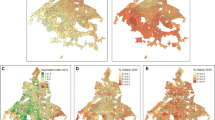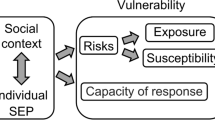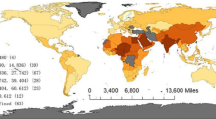Abstract
Quantifying spatial distribution patterns of air pollutants is imperative to understand environmental justice issues. Here we present a landscape-based hierarchical approach in which air pollution variables are regressed against population demographics on multiple spatiotemporal scales. Using this approach, we investigated the potential problem of distributive environmental justice in the Phoenix metropolitan region, focusing on ambient ozone and particulate matter. Pollution surfaces (maps) are evaluated against the demographics of class, age, race (African American, Native American), and ethnicity (Hispanic). A hierarchical multiple regression method is used to detect distributive environmental justice relationships. Our results show that significant relationships exist between the dependent and independent variables, signifying possible environmental inequity. Although changing spatiotemporal scales only altered the overall direction of these relationships in a few instances, it did cause the relationship to become nonsignificant in many cases. Several consistent patterns emerged: people aged 17 and under were significant predictors for ambient ozone and particulate matter, but people 65 and older were only predictors for ambient particulate matter. African Americans were strong predictors for ambient particulate matter, while Native Americans were strong predictors for ambient ozone. Hispanics had a strong negative correlation with ambient ozone, but a less consistent positive relationship with ambient particulate matter. Given the legacy conditions endured by minority racial and ethnic groups, and the relative lack of mobility of all the groups, our findings suggest the existence of environmental inequities in the Phoenix metropolitan region. The methodology developed in this study is generalizable with other pollutants to provide a multi-scaled perspective of environmental justice issues.




Similar content being viewed by others
References
Andersen ZJ, Wahlin P, Raaschou-Nielsen O, Scheike T, Loft S (2007) Ambient particle source apportionment and daily hospital admissions among children and elderly in Copenhagen. J Expo Sci Environ Epidemiol 17(7):625–636
Baden BM, Noonan DS, Turaga RMR (2007) Scales of justice: is there a geographic bias in environmental equity analysis?. J Environ Plann Manag 50(2):163–185
Bolin B, Barreto JD, Hegmon M, Meierotto L, York A (2013) Double exposure in the sunbelt: The sociospatial distribution of vulnerability in Phoenix, Arizona. In: Boone C, Fragkias M (eds) Urbanization and sustainability: Linking urban ecology, environmental justice and global environmental change. Springer, The Netherlands, pp. 159-178.
Bolin B, Grineski S, Collins T (2005) The Geography of Despair: Environmental Racism and the Making of South Phoenix, Arizona, USA. Hum Ecol Rev 12(2):156–168
Bolin B, Matranga E, Hackett EJ, Sadalla EK, Pijawka KD, Brewer D, Sicotte D (2000) Environmental equity in a sunbelt city: the spatial distribution of toxic hazards in Phoenix, Arizona. Env Hazards 2:11–24
Bolin B, Nelson A, Hackett EJ, Pijawka KD, Smith CS, Sicotte D, Sadalla EK, Matranga E, O’Donnell M (2002) The ecology of technological risk in a Sunbelt city. Env Plan 34:317–339
Boone CG (2008) Improving resolution of census data in metropolitan areas using a dasymetric approach: Applications for the Baltimore Ecosystem Study. Cities Env 1(1):3. doi:http://digitalcommons.lmu.edu/cate/vol1/iss1/3
Boone CG, Fragkias M, Buckley GL, Grove JM (2014) A long view of polluting industry and environmental justice in Baltimore. Cities 36(0):41–49. doi:http://dx.doi.org/10.1016/j.cities.2013.09.004
Brulle RJ, Pellow DN (2006) Environmental Justice: Human Health and Environmental Inequalities. Annu Rev Public Health 27(1):103–124
Brunsdon C, Fotheringham AS, Charlton M (1999) Some Notes on Parametric Significance Tests for Geographically Weighted Regression. J Reg Sci 39(3):497–524
Bullard RD (1990) Dumping in Dixie: Race, Class, and Environmental Quality. Westview Press, Boulder, CO
Chakraborty J (2009) Automobiles, Air Toxics, and Adverse Health Risks: Environmental Inequities in Tampa Bay, Florida. Ann Assoc Am Geogr 99(4):674–697
Chakraborty J, Maantay JA, Brender JD (2011) Disproportionate Proximity to Environmental Health Hazards: Methods, Models, and Measurement. Am J Public Health 101(S1):S27–S36
Clements AL, Fraser MP, Upadhyay N, Herckes P, Sundblom M, Lantz J, Solomon PA (2013) Characterization of summertime coarse particulate matter in the Desert Southwest—Arizona, USA. J Air Waste Manag Assoc 63(7):764–772. doi:10.1080/10962247.2013.787955
Cressie N (1990) The Origins of Kriging. Math Geol 22(3):239–252
Cutter SL, Holm D, Clark L (1996) The Role of Geographic Scale in Monitoring Environmental Justice. Risk Analysis 16(4):517–526
Cutter SL, Solecki WD (1996) Setting environmental justice in space and place: Acute and chronic airborne toxic releases in the southeastern United States. Urban Geography 17(5):380–399
Diem JE (2003) A critical examination of ozone mapping from a spatial-scale perspective. Environ Pollut 125(3):369–383
Diem JE, Comrie AC (2002) Predictive mapping of air pollution involving sparse spatial observations. Environ Pollut 119(1):99–117
Dimitrova R, Lurponglukana N, Fernando HJS, Runger GC, Hyde P, Hedquist BC, Anderson J, Bannister W, Johnson W, Baklanov A (2012) Relationship between particulate matter and childhood asthma—basis of a future warning system for central Phoenix. Atmos Chem Phys 12(5):2479–2490
Ellis AW, Hildebrandt ML, Fernando HJS (1999) Evidence of lower-atmospheric ozone “sloshing” in an urbanized valley. Phys Geogr 20(6):520–536
ESRI (2010) ArcMap Version 10.0. ESRI (Environmental Systems Resource Institute), Redlands, CA
Fernando HJS, Dimitrova R, Runger G, Lurponglukana N, Hyde P, Hedquist B, Anderson J (2009) Children’s health project: Linking asthma to PM10 in central Phoenix – a report to the Arizona department of environmental quality. Arizona State University’s Center for Environmental Fluid Dynamics and Center for Health Information and Research. http://www.azdeq.gov/ceh/download/Health%20Project%20Report.pdf. Accessed 26 Feb 2014.
Fortin MJ, Dale MRT (2005) Spatial Analysis: A Guide for Ecologists. Cambridge University Press, Cambridge, UK
Gamma Design Software (2006) GS+: Geostatistics for the Environmental Sciences, 7.0 (Build 25) edn. Gamma Design Software, Plainwell, Michigan, USA
Gilbert A, Chakraborty J (2011) Using geographically weighted regression for environmental justice analysis: Cumulative cancer risks from air toxics in Florida. Soc Sci Res 40(1):273–286
Giordano A, Cheever L (2010) Using dasymetric mapping to identify communities at risk from hazardous waste generation in San Antonio, Texas. Urban Geogr 31(5):623–647
Gregg JW, Jones CG, Daws TE (2003) Urbanization effects on tree growth in the vicinity of New York City. Nature 424:183–187
Grineski S (2007) Incorporating health outcomes into environmental justice research: the case of children’s asthma and air pollution in Phoenix, Arizona. Env Hazards 7:360–371
Grineski S, Bolin B, Boone C (2007) Criteria air pollution and marginalized populations: environmental inequity in metropolitan Phoenix, Arizona. Soc Sci Q 88 (2).
Grineski SE, Collins TW (2008) Exploring patterns of environmental injustice in the global south: “Maquiladoras” in Ciudad Juárez, Mexico. Popul Environ 29(6):247–270
Hayes A, Cai L (2007) Using heteroskedasticity-consistent standard error estimators in OLS regression: An introduction and software implementation. Behav Res Methods 39(4):709–722
Huby M, Cinderby S, White P, Bruin Ad (2009) Measuring inequality in rural England: the effects of changing spatial resolution. Environ Plann A 41(12):3023–3037
IBM Corp (2013) IBM SPSS Statistics for Windows, 22.0 edn. IBM Corp, Armonk, NY
Jelinski DE, Wu JG (1996) The modifiable areal unit problem and implications for landscape ecology. Landscape Ecol 11(3):129–140
Jerrett M, Burnett RT, Kanaroglou P, Eyles J, Finkelstein N, Giovis C, Brook JR (2001) A GIS—environmental justice analysis of particulate air pollution in Hamilton, Canada. Environ Plann A 33(6):955–973
Kissling WD, Carl G (2008) Spatial autocorrelation and the selection of simultaneous autoregressive models. Global Ecol Biogeogr 17(1):59–71
Lippmann M (1989) Health Effects of Ozone; A Critical Review. JAPCA 39(5):672–695
Meeks EV (2007) Border citizens: the making of Indians, Mexicans, and Anglos in Arizona. University of Texas Press, Austin, Texas
Mohai P, Saha R (2007) Racial inequality in the distribution of hazardous waste: a national-level reassessment. Soc Probl 54(3):343–370. doi:10.1525/sp.2007.54.3.343
Noonan DS (2008) Evidence of environmental justice: a critical perspective on the practice of EJ research and lessons for policy design. Soc Sci Q 89(5):1153–1174
Noonan DS, Turaga RM, Baden BM (2009) Superfund, hedonics, and the scales of environmental justice. Environ Manage 44(5):909–920
Openshaw S (1984) The Modifiable Areal Unit Problem. Geo Books, Norwich
Páez A (2004) Anisotropic variance functions in geographically weighted regression models. Geogr Anal 36(4):299–314
Pope CA, Dockery DW (2006) Health effects of fine particulate air pollution: lines that connect. J Air Waste Manag Assoc 56(6):709–742
Pope RL, Wu J (2014a) Characterizing air pollution patterns on multiple time scales in urban areas: a landscape ecological approach. Urban Ecosyst 17(3):855–874. doi:10.1007/s11252-014-0357-0
Pope RL, Wu J (2014b) A multi-objective assessment of an air quality monitoring network using environmental, economic, and social indicators and GIS-based models. J Air Waste Manag Assoc 64(6):721–737. doi:10.1080/10962247.2014.888378
Rechtschaffen C (2003) Advancing environmental justice norms. UC Davis L Rev 37:95
Tecer LH, Alagha O, Karaca F, Tuncel G, Eldes N (2008) Particulate matter (PM2.5, PM10-2.5, and PM10) and children’s hospital admissions for asthma and respiratory diseases: a bidirectional case-crossover study. J Toxicol Environ Health, Part A 71(8):512–520
U.S. EPA (2015) The Green Book Non-Attainment Areas for Criteria Pollutants. Environmental Protection Agency. http://www.epa.gov/oaqps001/greenbk/index.html. Accessed 25 March 2015.
United Church of Christ (UCC) (1987) Toxic wastes and race in the United States: a national report on the racial and socio-economic characteristics of communities with hazardous waste sites. United Church of Christ, Commission for Racial Justice, New York
Williams RW (1999) The contested terrain of environmental justice research: community as unit of analysis. Soc Sci J 36(2):313–328. doi:http://dx.doi.org/10.1016/S0362-3319(99)00008-7
Wu J (2007) Scale and scaling: A cross-disciplinary perspective. In: Wu JG, Hobbs RJ (eds) Key topics in landscape ecology. Cambridge University Press, Cambridge, UK, pp. 115-142.
Wu J, Jenerette GD, Buyantuyev A, Redman CL (2011) Quantifying spatiotemporal patterns of urbanization: the case of the two fastest growing metropolitan regions in the United States. Ecol Complex 8(1):1–8
Acknowledgments
We are grateful to the three anonymous reviewers who provided excellent comments to help strengthen our manuscript.
Author information
Authors and Affiliations
Corresponding author
Ethics declarations
Conflict of interest
The authors declare that they have no conflict of interest.
Electronic supplementary material
Rights and permissions
About this article
Cite this article
Pope, R., Wu, J. & Boone, C. Spatial patterns of air pollutants and social groups: a distributive environmental justice study in the phoenix metropolitan region of USA. Environmental Management 58, 753–766 (2016). https://doi.org/10.1007/s00267-016-0741-z
Received:
Accepted:
Published:
Issue Date:
DOI: https://doi.org/10.1007/s00267-016-0741-z




